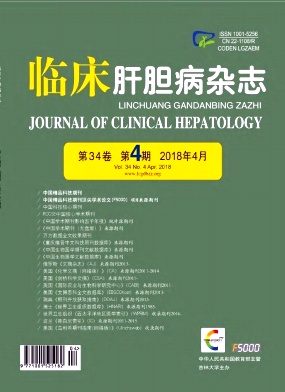|
[1]European Association for the Study of the Liver.EASL clinical practice guidelines:autoimmune hepatitis[J].J Hepatol, 2015, 63 (4) :971-1004.
|
|
[2]Chinese Society of Hepatology, Chinese Medical Association;Chinese Society of Gastroenterology, Chinese Medical Association;Chinese Society of Infectious Diseases, Chinese Medical Association.Consensus on the diagnosis and management of autoimmune hepatitis (2015) [J].J Clin Hepatol, 2016, 32 (1) :9-22. (in Chinese) 中华医学会肝病学分会, 中华医学会消化病学分会, 中华医学会感染病学分会.自身免疫性肝炎诊断和治疗共识 (2015) [J].临床肝胆病杂志, 2016, 32 (1) :9-22.
|
|
[3]CZAJA AJ, MANNS MP.Advances in the diagnosis, pathogenesis, and management of autoimmune hepatitis[J].Gastroenterology, 2010, 139 (1) :58-72.
|
|
[4]CZAJA AJ.Rapidity of treatment response and outcome in type 1autoimmune hepatitis[J].J Hepatol, 2009, 51 (1) :161-167.
|
|
[5]WANG Q, QIU D, MA X.Early normalization of aminotransferase predicts complete biochemical remission in autoimmune hepatitis patients[J].Aliment Pharmacol Ther, 2011, 34 (1) :107-109.
|
|
[6]ALVAREZ F, BERG PA, BIANCHI FB, et al.International Autoimmune Hepatitis Group report:review of criteria for diagnosis of autoimmune hepatitis[J].J Hepatol, 1999, 31 (5) :929-938.
|
|
[7]LUTH S, HERKEL J, KANZLER S, et al.Serologic markers compared with liver biopsy for monitoring disease activity in autoimmune hepatitis[J].J Clin Gastroenterol, 2008, 42 (8) :926-930.
|
|
[8]CZAJA AJ.Advances in the current treatment of autoimmune hepatitis[J].Dig Dis Sci, 2012, 57 (8) :1996-2010.
|
|
[9]GLEESON D, HENEGHAN MA, British Society of Gastroenterology.British Society of Gastroenterology (BSG) guidelines for management of autoimmune hepatitis[J].Gut, 2011, 60 (12) :1611-1629.
|
|
[10]FRIEDMAN SL.Liver fibrosis—from bench to bedside[J].J Hepatol, 2003, 38 (Suppl 1) :s38-s53.
|
|
[11]LIEBER CS.Prevention and treatment of liver fibrosis based on pathogenesis[J].Alcohol Clin Exp Res, 1999, 23 (5) :944-949.
|
|
[12]PINZANI M, ROINBOUTS K.Liver fibrosis:from the bench to clinical targets[J].Dig Liver Dis, 2004, 36 (4) :231-242.
|
|
[13]TAKIGAWA T, MIYAZAKI H, KINOSHITA M, et al.Glucocorticoid receptor-dependent immunomodulatory effect of ursodeoxycholic acid on liver lymphocytes in mice[J].Am J Physiol Gastrointest Liver Physiol, 2013, 305 (6) :427-438.
|
|
[14]YASUHIRO M, YOSHIAKI I, HARUHIKO K, et al.Efficacy of ursodeoxycholic acid for Japanese patients with autoimmune hepatitis[J].Hepatol Int, 2009, 3 (4) :556-562.
|
|
[15]LI YR, WANG WB, ZHANG LY, et al.The analysis of efficacy of glycyrrhizin therapy for autoimmune hepatitis[J].J Clin Hepatol, 2007, 23 (2) :117-118. (in Chinese) 李蕴铷, 王文冰, 张黎颖, 等.甘草酸类药物治疗自身免疫性肝炎疗效分析[J].临床肝胆病杂志, 2007, 23 (2) :117-118.
|
|
[16]Expert Committee on Clinical Application of Glycyrrhizin Preparation in the Treatment of Liver Diseases.Expert consensus on clinical application of glycyrrhizin preparation in the treatment of liver diseases[J].J Clin Hepatol, 2016, 32 (5) :844-852. (in Chinese) 甘草酸制剂肝病临床应用专家委员会.甘草酸制剂肝病临床应用专家共识[J].临床肝胆病杂志, 2016, 32 (5) :844-852.
|
|
[17]SELVARAJAH V, MONTANO-LOZA AJ, CZAJA AJ.Systematic review:managing suboptimal treatment responses in autoimmune hepatitis with conventional and nonstandard drugs[J].Aliment Pharmacol Ther, 2012, 36 (8) :691-707.
|
|
[18]LIU L, LI XD, XIAO MZ, et al.Correlation analysis of autoantibodies and biochemical indicators in patients with autoimmune hepatitis typeⅠ[J/CD].Chin J Liver Dis:Electronic Edition, 2016, 8 (2) :14-18. (in Chinese) 刘玲, 李晓东, 肖明中, 等.自身免疫性肝炎Ⅰ型患者自身抗体与血清生物化学指标的相关性分析[J/CD].中国肝脏病杂志:电子版, 2016, 8 (2) :14-18.
|
|
[19]QIU DK, MA X, SHENG L.Study on strengthening the response to the treatment of autoimmune hepatitis[J].Chin J Dig, 2013, 33 (1) :2-4.邱德凯, 马雄, 盛黎.加强对自身免疫性肝炎治疗应答的研究[J].中华消化杂志, 2013, 33 (1) :2-4.
|







 DownLoad:
DownLoad: